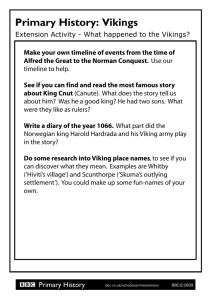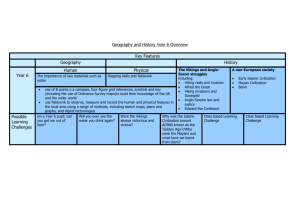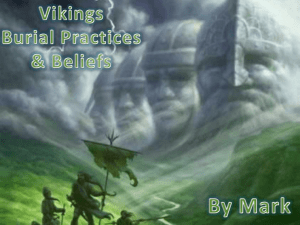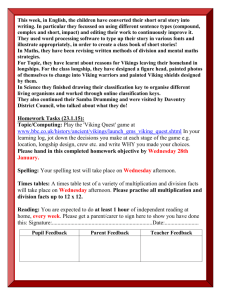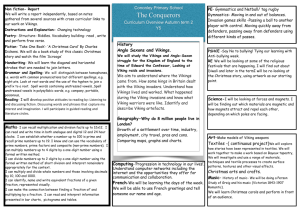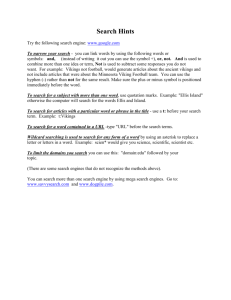Viking Voyages
advertisement
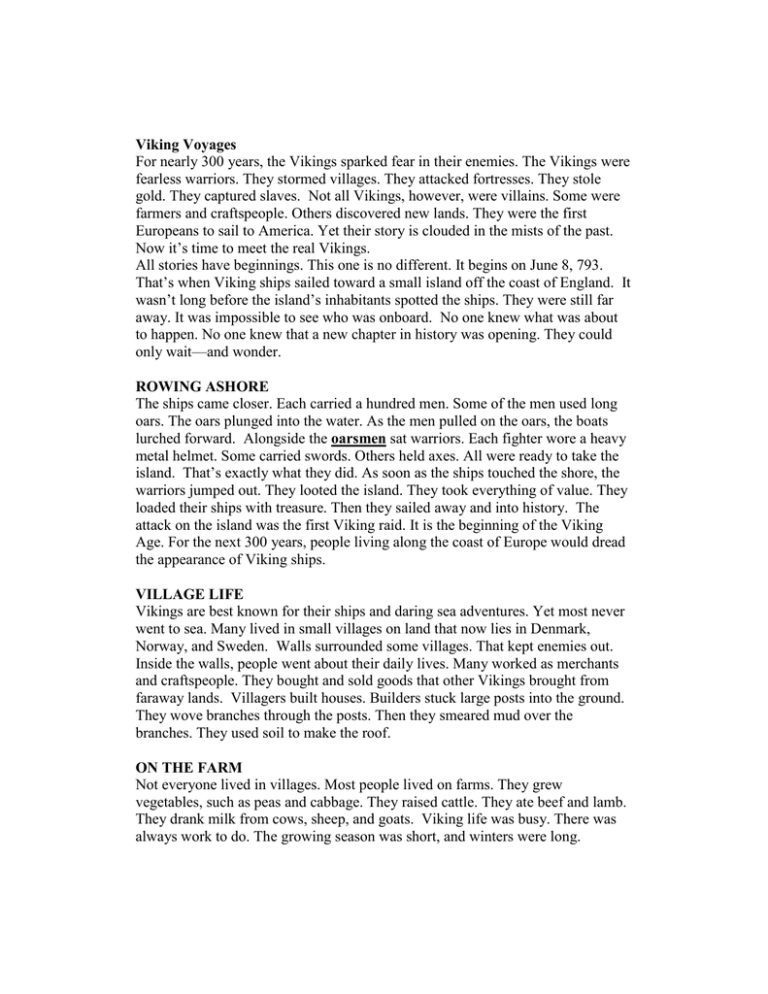
Viking Voyages For nearly 300 years, the Vikings sparked fear in their enemies. The Vikings were fearless warriors. They stormed villages. They attacked fortresses. They stole gold. They captured slaves. Not all Vikings, however, were villains. Some were farmers and craftspeople. Others discovered new lands. They were the first Europeans to sail to America. Yet their story is clouded in the mists of the past. Now it’s time to meet the real Vikings. All stories have beginnings. This one is no different. It begins on June 8, 793. That’s when Viking ships sailed toward a small island off the coast of England. It wasn’t long before the island’s inhabitants spotted the ships. They were still far away. It was impossible to see who was onboard. No one knew what was about to happen. No one knew that a new chapter in history was opening. They could only wait—and wonder. ROWING ASHORE The ships came closer. Each carried a hundred men. Some of the men used long oars. The oars plunged into the water. As the men pulled on the oars, the boats lurched forward. Alongside the oarsmen sat warriors. Each fighter wore a heavy metal helmet. Some carried swords. Others held axes. All were ready to take the island. That’s exactly what they did. As soon as the ships touched the shore, the warriors jumped out. They looted the island. They took everything of value. They loaded their ships with treasure. Then they sailed away and into history. The attack on the island was the first Viking raid. It is the beginning of the Viking Age. For the next 300 years, people living along the coast of Europe would dread the appearance of Viking ships. VILLAGE LIFE Vikings are best known for their ships and daring sea adventures. Yet most never went to sea. Many lived in small villages on land that now lies in Denmark, Norway, and Sweden. Walls surrounded some villages. That kept enemies out. Inside the walls, people went about their daily lives. Many worked as merchants and craftspeople. They bought and sold goods that other Vikings brought from faraway lands. Villagers built houses. Builders stuck large posts into the ground. They wove branches through the posts. Then they smeared mud over the branches. They used soil to make the roof. ON THE FARM Not everyone lived in villages. Most people lived on farms. They grew vegetables, such as peas and cabbage. They raised cattle. They ate beef and lamb. They drank milk from cows, sheep, and goats. Viking life was busy. There was always work to do. The growing season was short, and winters were long. Farmers had to make sure they had enough food to last through the cold winters. Still, Vikings tried to have some fun. They liked to ski and swim. They played chess and a game similar to checkers. They also practiced their religion. Vikings believed in many gods. Odin was the king of their gods. He soared through the sky on an eight-legged horse. Thor was another god. Vikings always knew when he was nearby. Lightning flashed and thunder boomed as Thor rode his chariot through the sky. Some of the names for the days of the week come from these gods. For example, Thursday comes from a Viking word meaning Thor’s day. Friday comes from Frigg’s day. Frigg was Odin’s wife. SHIP AHOY! Viking villages were similar to many villages at the time. Their ships, however, were very different. Viking ships were engineering marvels for their day. No one else had anything like them. Indeed, the Vikings owed much of their success to their shipbuilders. Each ship was built for speed. The hulls were designed to glide over waves. That made them faster than ships that just plowed through the water. Large, colorful sails caught the wind, pushing the ships over open water. Some of the sails were 40 feet across. When ships moved close to shore or up rivers, the Vikings took the sails down. They then used the oars. Ships had up to 50 oars. These speedy ships were large. Some were more than 90 feet long. They could carry both warriors and horses. THE DISCOVERERS Some Viking men left their wives, families, and homes to go on long voyages. They were often away for years at a time. These amazing journeys took them to faraway lands. Vikings sailed to England, France, Spain, and Italy. They went to Africa and Asia. They were the first Europeans to come to America. The trip to America was slow and had several stops along the way. In 860, Vikings discovered Iceland. Forty years later, a Viking named Erik the Red found Greenland. NEW LANDS These were exciting times. Vikings were discovering new lands. They were moving to new places. Then came word of a sighting of uncharted land. Erik the Red wanted to go there. He never made it, though. On the way to his ship, Erik fell off his horse. Fearing bad luck, he canceled the trip. Erik’s son, Leif Eriksson, did make the voyage later. He not only spotted land; he went ashore. He named the new land Vinland. It was the East Coast of North America. He probably sailed along the coast. He may have even sailed to what is now New York City. MYSTERY MAP There is much evidence that Vikings settled in North America. Ancient legends tell of their Vinland adventures. Archaeologists have found a Viking village in Canada. There may even be a Viking map that shows Vinland. The map is a bit faded. You can see parts of Europe clearly drawn. You can also see Iceland and Greenland. Beyond those islands is Vinland. It doesn’t look much like North America today. After all, Vikings only knew about a small part of the continent. Not everyone agrees that Vikings drew this map. Some think it’s a fake. They point out that it is the only known Viking map. Why make just one map? Vikings had no idea how important America would become. The map is just one more mystery about the Vikings’ never-ending story. Scientists are still searching for more clues about the Vikings’ past. Perhaps we will never know their full story. Yet one thing is sure. The Vikings’ colorful stories are an important part of American history. Article by Fran Downey. Top-of-page photo by Antony Wootten. "Viking Voyages" appears on pages 6-13 of National Geographic Kids Nov.-Dec. 2005 issue.
